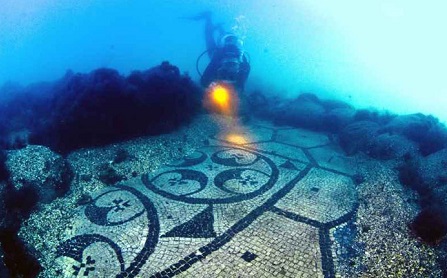Sunken Cities

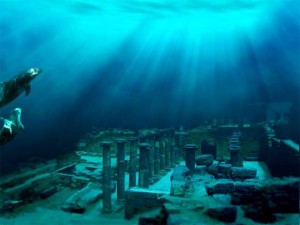
10 sunken cities of the Ancient World
The history of the ancient almost mythical civilization of Atlantis, still stirs the imagination. The idea that the city just went under water due to natural disaster, excites consciousness. Therefore, in each new settlement, which is under the water, see the mythical Atlantis.
Here, we’ll show you the ten most famous sunken cities.
1. Tronis – Heraklion, Egypt
This city Greeks called Heraklion, and the Egyptians – Tronis. Once he was on the northern coast of Egypt and was considered one of the most important port cities of the Mediterranean, and now he’s at the bottom of the sea, which once served. Recently, a city that 1200 years, was found under water and gradually opens its secrets. Artifacts that rises to the surface, indicate that at one time it was a big shopping center and busiest port.More than 60 ancient ships that were sunk in the port area for various reasons, also found, along with hundreds of anchors, coins, plates with inscriptions in Greek and Egyptian languages, large sculptures of the temples. These temples dedicated to the gods, remained almost untouched. The city was the official port of Egypt in the period from 664 to 332 BC. e. Now he is far from the coast, a distance of 6.5 km. As in many other sunken cities, artifacts preserved in good condition, that helps as accurately as possible recreate the paintings of everyday life of cities, their architecture and planning. If the answer to the question how the city were at the bottom of the sea, it is likely, as a result of the earthquake. Since the city is on the coast, then by geological processes could easily go under water.
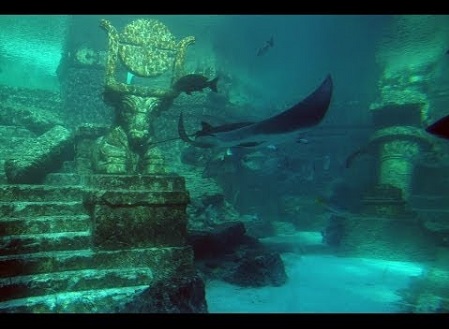
2. Phanagoria Russia / Greece
The ancient city Phanagoria hero myths and works of art, actually existed. If you read the history of Rome, it becomes known that in 63 BC. e. uprising has ended with that much of the city was burned, wife and kids of Mithradates VI were killed by an angry mob. A long period it was believed that this is just a myth, until archaeologists studied underwater Phanagoria necropolis and found a tombstone inscription which reads:”Gipsikratii, wife of Mithridates VI». Gipsikratii – it’s the male version of the name Gipsikratii. This tombstone has confirmed the reality of legends that Gipsikratii was bald, taciturn and courageous, so my husband addressing her, calling her a man’s name.
Phanagoria – the largest Greek city, which is now in Russia. It was based on the Black Sea coast in the 6th century BC and today is the third sunken city, which may be the legendary Atlantis.Were also found pedestals, on which stood a large statue, and a large number of urban artifacts. Having existed for 1500 years, the city was abandoned in the 10th century, but the reason for this is not known. From the 18th century, the city attracted the attention of archaeologists, but excavations go very slowly due to the nature of the bottom and a ball of sand, the width of which is 7 meters in some places.
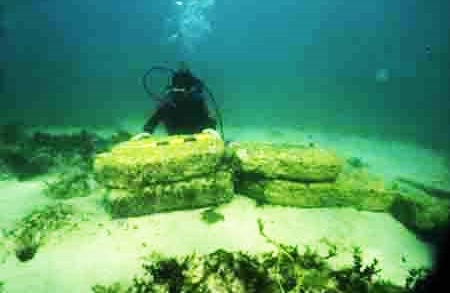
3. Palace of Cleopatra, Egypt
Part of ancient Alexandria is located on the ocean floor. City that 2000 years, for decades been the subject of archaeological excavations. It is a long and complex process, which overcomes a number of difficulties associated with depth and lack of visibility, hiding the sunken by an earthquake of the city.In addition to the royal palace, were found temples, neighborhoods, buildings and military outposts, large private facilities – all in excellent condition preserved over the centuries. Archaeologists have also found a palace complex of Cleopatra, which she called her and Mark Antony’s house, the place where she committed suicide instead of surrender to his captors.
Huge granite statues remain on the bottom of the ocean, in places where they once fell in a series of aftershocks of the earthquake in the period from the 4th to the 8th century BC There is also a house and Mark Antony, Timomium where he was hiding during difficult periods of life. Archaeologists have cleaned of sand temple of Isis, the statue of his father and the son of Cleopatra and other artifacts, including crockery, jewelry, amulets, small statues, ritual boats that have been raised to the surface.
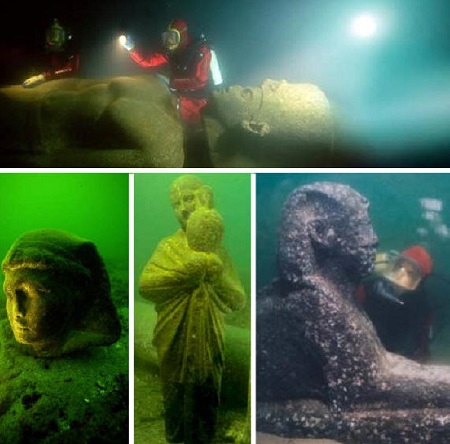
4. Shicheng, China
Shicheng Chinese city was founded 1,300 years ago, and most of the buildings appeared over the next 300 years after its founding. The unique architecture includes buildings dating back to the Ming and Qing dynasties of the 14th century. Nothing can to resist the progress, and also the city Shinchen could not resisted, in 1959, he was flooded a result of construction hydroelectric power. More than 300 000 people left home of their ancestors. Today the city is under water at a depth of 40m and is well preserved.
The city is not completely lost. In 2001, the Chinese government has an interest in his fate and found that it is quite well preserved, if not water, it seems that the city continues to live. The walls date from the 16th century and are still standing, including the city gates, and numerous statues. Today divers in a new way discovering this city and its greatness.
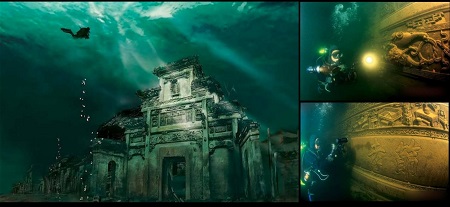
5. Olous, Crete, Greece
If the majority of sunken cities or physically difficult to reach because there are intensive excavations of the ruins of the city of Olous available to all. It was founded on the northeast coast of Crete, and lived there from 30 000 to 40 000 inhabitants.The city was not built on the rocks, like all Cretan cities, but on the sand, like most of sunken cities. A powerful impetus to the earthquake, and it was under water. Today, people swim with scuba diving and swimming tubes can make fascinating underwater walk, exploring the ruins and finding sunken artifacts, such as coins. Some designs, such as the walls are partly above the sea surface.
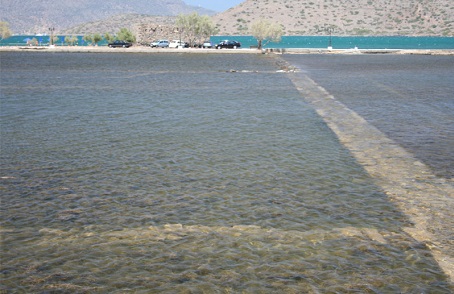
6. Mulifanua, Samoa
Tribe Lapita settlers Micronesia and Polynesia, settled on the island after leaving Taiwan and East Asia around 2000 BC. In 500 BC they established several settlements on the islands of the Pacific. These people were talented sailors and craftsmen, especially in making dishes. On the islands of Samoa were found more than 4000 copies of dishes belonging to Lapita.
Archaeologists believe that the settlement Mulifanua was founded 3,000 years ago, during the period of the great migration of the island in the Pacific. It is a confirmation of the existence of Lapita. At that time the island was sandy and wide. It is not known how many more settlements located here, as over the centuries water and sand concealed physical evidence, except shards, which is on the coast.
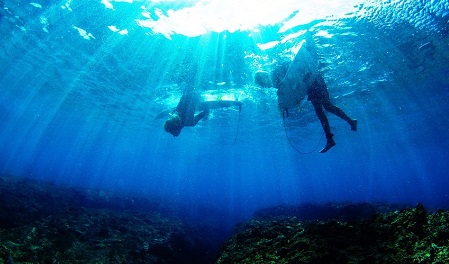
7. Dwarka, Gulf of Cambay, India
In 2002, the Indian Bay were found the ruins of the ancient city. Since they are located at a depth of 40 m, then found they were completely random by a team, that investigated the level of water pollution. This finding led archaeologists to reconsider the timeframe of civilization in the region. The city was founded 5000 years ago. Initially, the city is considered the oldest 4,000 years of Harappa. Mesopotamian city was known sewage systems and water harvesting, well-planned streets, ports and fortifications. Rumor has it that it was founded by the direct descendants who survived after their first city sank.
Shards, beads, sculpture and human bones were found at the site of the new found sunken city. According to the results of the carbon analysis of the remains of people 9,500 years. At that time, the sea level was much lower. The city was on the shore and was swallowed by a wave of rising water from melting glaciers. Remains of settlements were built in the river bed.
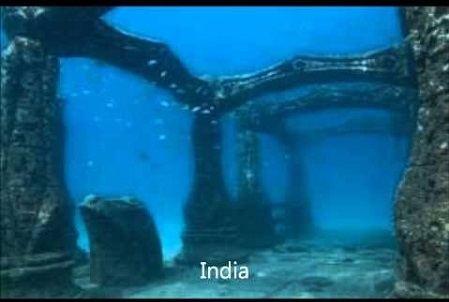
8. The ruins of the ancient city near Lake Titicaca, Bolivia / Peru
Around Lake Titicaca soars many legends. Even today, local people consider it sacred. The depth of the lake and the poor visibility complicate studies of the bottom, and ignorance breeds legend. Recently, a team of divers and researchers from society Akakor Geographical Exploring made 200 dives to the ruins of the sunken city.At the bottom were found ruins of temples, fragments of roads, walls and terraces, which once was grown agricultural plants. It has long been among the locals could be heard talking about the sunken city, but only by the development of technology, it became possible to dive. Remains of the temple complex was found at a depth of 20 meters, where divers proceeded along found at the bottom of the road that led to their discovery.
At the bottom of the lake, researchers have found many artifacts, which included fragments of gold, ceramic statues, stone statues, boats, bones of humans and animals and containers with incense.
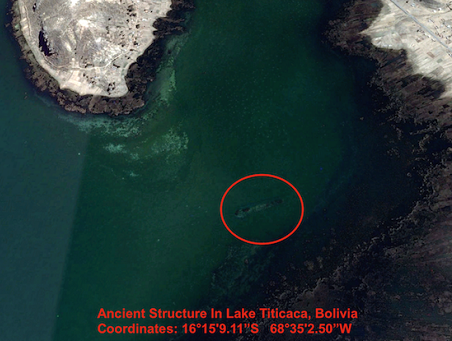
9. Atlit-Yam, Israel
Atlit-Yam – a name that was given to several buildings of the Neolithic period, which were discovered on the shores of Carmel. These buildings were stone walls, foundations of houses and other buildings, the foundations of a round shape and the ancient road. It has been estimated that the structures were built 7550 and 8000 years ago, and were destroyed by the tsunami caused by the volcanic activity.In the center of the settlement was construction in the form laid out in a circle of stones, resembling a place of sacrifice, there was also the source of water. Some stones standing upright, and others – lying most likely they were tables for sacrifices.
Human remains were also found here, including the skeletons of 65 men, women and children. Detailed inspection findings led to the fact that revealed traces of tuberculosis, in which people died. The world’s first deadly disease manifestations dating back 7000-8000 years. More found stone, flint and bone tools. Furthermore, were found seeds of native plants: flax and barley. Findings suggest that people not only were fishing, but also engaged in livestock and crop production.
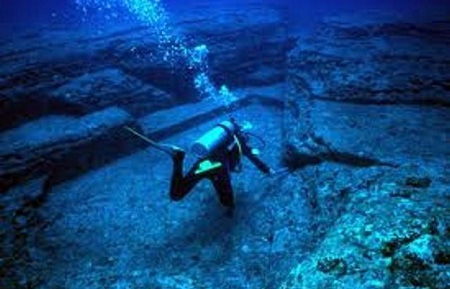
10. Bailly, Italy
Bailly – an ancient Roman city, whose lifestyle was like Sodom and Gomorrah style. There was going nobility for games and recreation. It been Julius Caesar and Nero. The city had a lot of hot springs, as he stood in the zone of active geological processes that contributed to the development of business and spa bath treatments.In the 8th century, Saracens captured the city, after which the former glory was never returned to him, and about 1500 inhabitants left it. After some time, the city gradually fell into waters of the bay.
Today, these places are valuable from an archaeological point of view. Many tourists come here by boat to dive in search of artifacts. There was found a statue of Odysseus, villas, arcades and ruins ponds for breeding fish and oysters. The researchers also found the famous villa of Nero, which was built in the 1st century BC.
